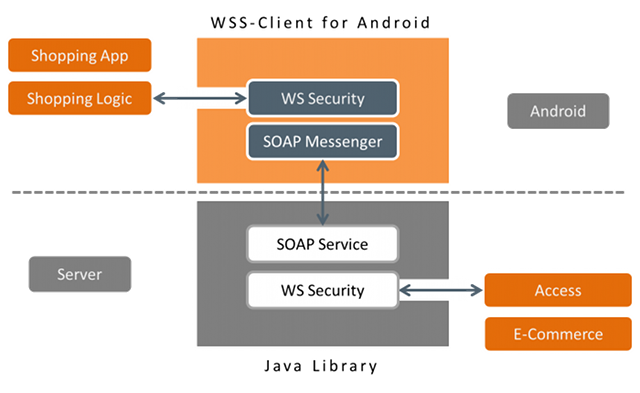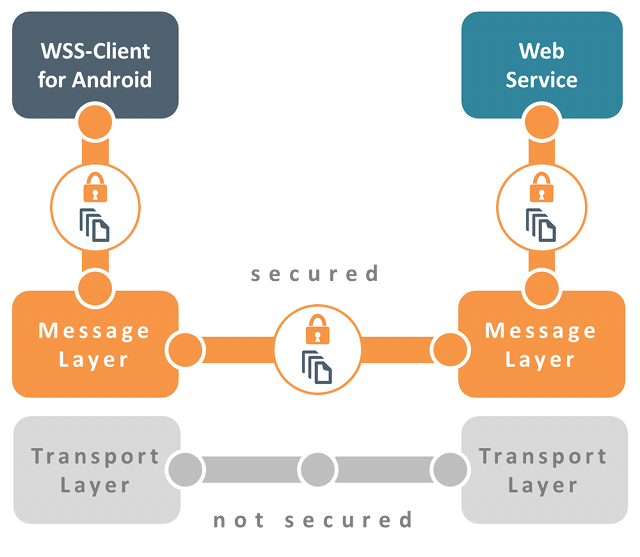This project brings the SOAP protocol (Simple Object Access Protocol) and Web Service Security (WSS) Android platforms. WSS-Client for Android makes it possible to securely access web services from the mobile sector.
The image below describes WSS-Client for Android in the context of e.g. an e-commerce environment.
WSS-Client for Android implements the OASIS Web Service Security (WSS) standard for Android platforms and makes XML Encryption and XML Signature available for tablets and smartphones.
XML Signature describes an XML syntax for digital signatures and is defined in the W3C recommendation "XML Signature Syntax and Processing". Signing a certain information ensures information integrity and protects against falsification. A digital signature may also be used to uniquely determine the digital identity of a certain user, which is a trustworthy basis for further access control mechanisms.
XML Encryption is a specification that is governed by a W3C recommendation and defines how to encryt the content of an XML element. An XML element in this context is either an XML message as a whole or selected parts of a message. This makes it even more flexible to adequately respond to the security needs of enterprise data.
Web Service Security secures data and ensures integrity. It guarantees end-to-end security and is independent of the security mechanism provided by the transport layer. It is a must for a secure shopping experience.
SOAP Messenger is a key component to access SOAP based web services from tablets and smartphones. With this component, mobile devices are enabled to seamlessly integrate with Software as a Service. The SOAP messenger module provides the basis for a secure message exchange, and, combined with WSS overcomes the well-known security issues on the transport level.
The class SOAPMessengeris the starting point to either understand the functionality of WSS-Client for Android or directly integrate into the specific application logic.
public SOAPMessage sendRequest(SOAPMessage message, String endpoint) throws Exception {
if (initialized == false)
throw new Exception("[SOAPMessenger] Is not initialized");
SOAPMessage responseMessage = null;
// send SOAP message to web service identified by its url
SOAPResponse soapResponse = this.soapSender.doSoapRequest(message, endpoint);
int httpStatus = soapResponse.getHttpStatus();
if (httpStatus == 200) {
InputStream data = soapResponse.getData();
if (data == null) throw new Exception("No response data retrieved.");
responseMessage = new SOAPMessage(data);
}
return responseMessage;
}
PKCS#11 is a member of the Public-Key Cryptography Standards (PKCS) family. It defines a platform-independent interfaces to Hardware Security Modules such as smartcards. WSS-Client for Android supports this standard und grants access to the user's smartcard to read his public also private key to secure the SOAP based communication.
###PKCS#12
PKCS#12 is another member of the Public-Key Cryptography Standards family, that is supported by WSS-Client for Android. This standard defines a file format, that is used to store the private key and digital certificate (X.509) of a certain user.


